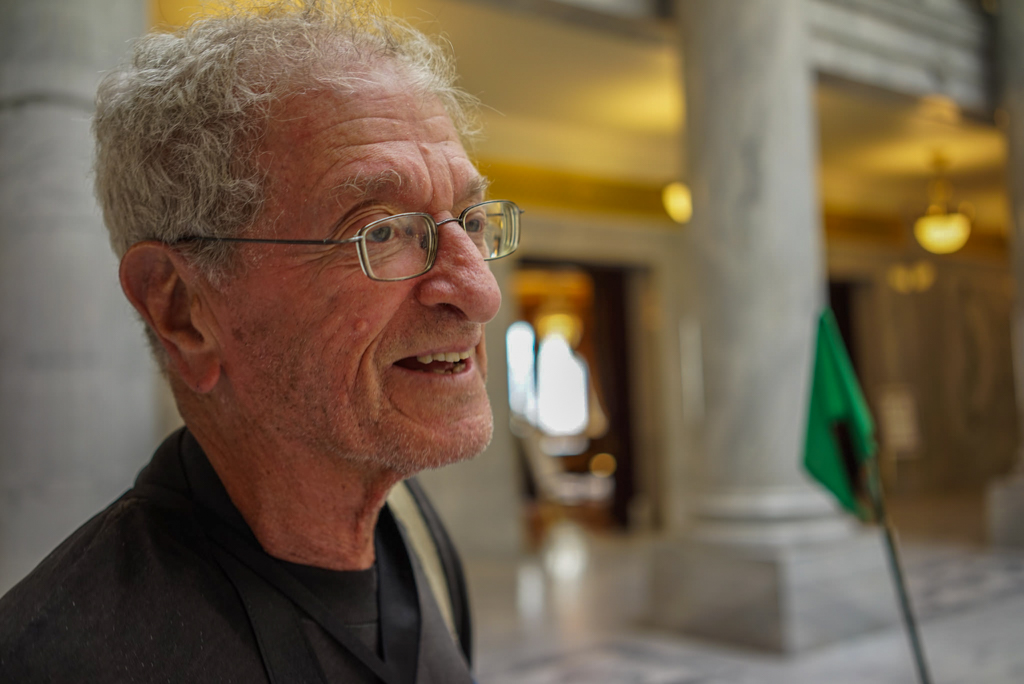
<< Previous Photo | Next Photo >>
Continue the ADAPT Thread of Photos
Continue the PEOPLE Thread of Photos
Harvey Finkle is a documentary still photographer who has produced a substantial body of work concerned with social, political and cultural issues. His work has been extensively exhibited and published, including four books entitled, “Urban Nomads,” “Still Home: Jews of South Philadelphia”, “Reading”, and “Independent Living: The People Behind the Movement."
His recent work includes a documentation of the Kensington Welfare Rights Union (KWRU), a poor people’s movement emanating from the poorest neighborhood in Pennsylvania; “The Jews of South Philadelphia,” interviews and photographs of the remnants of what once was among the largest Jewish communities in the nation; and an Independent Living series for Liberty Resources, Philadelphia’s Center for Independent Living for people with disabilities.
His ongoing work includes documenting the activities of many progressive organizations including a death penalty abolitionist group, ACT-UP, ADAPT (disabled activists), KWRU, and other groups concerned with housing and homelessness. Also, his work includes an extensive inventory of images depicting all aspects of life in Deaf culture, plus a substantial collection of photos dealing with education.
Works in progress are about the new wave of immigrant and refugee families who have settled in urban areas and the evolving Transgender community.
Anyone who walks the hallways of a Project HOME residence, reads News from HOME, or browses our website is captured by the amazing photography of Harvey Finkle. Harvey has been an integral member of the Project HOME community since our founding—and, in a sense, for many years before that. He has committed decades to documenting the struggles of persons on the margins—in Philadelphia, nationally, and internationally.
Harvey came to his life’s vocation in a roundabout way. After earning a graduate degree in social work at the University of Pennsylvania, he was first assigned to work with families accused of neglecting their children and then with an experimental preschool project. Both exposed him to people living in poverty. His upbringing by Roosevelt Democrats made him quickly sympathetic to those with whom he worked. A passion for documenting the dignity and power of persons who often go unnoticed drove his work.
Not until many years later did he discover that photography was his medium. An exhibit of Harry Callahan’s photos at the Museum of Modern Art whet his interest, but he didn’t even buy a camera until five years later, in 1967.
“And I don’t think I took a good picture for three years after that,” he quips. Harvey’s growing interest in photography mixed well with his wish to illuminate the experiences of those at the margins who often go unseen. This included people who lived in poverty, were recent immigrants, lived with disabilities, or experienced homelessness.
He first met Sister Mary Scullion in the mid-1980s and asked her if he could photograph the residents of Women of Hope, a transitional residence Sister Mary had founded. “One of the women Harvey photographed said that Harvey had ‘a third eye,’” Sister Mary Scullion remembers. “I thought this was such a great way to describe Harvey’s work. He can capture what most of us cannot even see.”
Harvey’s stunning work continues to shed light on the lives of those who are marginalized, and to engender empathy and action from those who view it. His time and talent have been priceless gifts to us over decades. Project HOME is truly fortunate to count him as a friend and a vital part of our mission.
My photos of photographers (Including Harvey): https://www.flickr.com/gp/timmwheat/85hV73
My best photos: https://flic.kr/s/aHsm3AXiF4
Legacy Lenses: https://www.flickr.com/gp/timmwheat/eN0728
My photo of Harvey at work in Denver 2018.
Photo by Tim Wheat.
<< Previous Photo | Next Photo >>